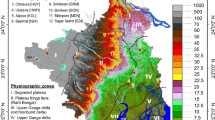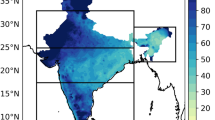Abstract
The low frequency spatio-temporal intraseasonal evolution of monsoon rainfall over India is studied by considering the pentad rainfall averages taken over 2.5° wide and 5.0° long blocks lying across the central longitudinal and latitudinal transacts. The time-latitude cross sections show south to north progressions of rainfall anomalies with a recurrence period of about 40 days. The progressions show considerable inter-annual and intra-seasonal variation in frequency, amplitude and rate of progression. The extended empirical orthogonal function analysis shows that the first two most important functions correspond to this northward progression of rain anomalies recurring after an interval of about 40 days. The rate of progression of anomalies is about 0.5° Lat./day. The time-longitude cross sections show the movement of rainfall anomalies towards both directions east and the west, with slight preference towards the east. The importance of these signals in rainfall forecasting is foreseen.
Similar content being viewed by others
References
Alexander, G., Keshavamurthy, R. N., U. S. De, Chellapa, R., Das, S. K. andPillai, P. V., (1978),Fluctuations of monsoon activity. Ind. J. Meteor. Hydro. Geophys.29, 76–87.
Anderson, J. R., Stevens, D. E. andJulian, P. R. (1984),Temporal variations of the tropical 40–50 day oscillation. Mon. Wea. Rev.,112, 2432–2438.
Chang, C. P., (1977),Viscous internal gravity waves and low frequency oscillations in the tropics. J. Atmos. Sci.24, 901–910.
Kripalani, R. H. Bansod, S. D. andSingh, S. V. (1985),The spatial and spatio-temporal features of weekly monsoon rainfall over India Submitted to Mausam.
Krishnamurti, T. andSubrahmanyam, D. (1982),The 30–50 day mode at 850 mb during Monex. J. Atmos. Sci.39, 2088–2095.
Krishnamurti, T. N., Jayakumar P. K., Sheng, J., Surgi, N. andKumar, A. (1985),Divergent circulations on the 30 to 50 day time scale. J. Atmos. Sci.42, 364–375.
Knutson, T. A., Weikmann, K. M. andKutzbach, J. E. (1985)Global scale intraseasonal oscillations of Outgoing Longwave Radiation and 250 mb zonal wind during Northern Hemisphere Summer. Mon. Wea. Rev. (to appear).
Lau, K. M. andChan, P. H. (1985)Aspects of the 40–50 day oscillation during the northern winter as inferred from outgoing longwave radiation. Mon. Wea. Rev.113, (to appear).
Lorenc, A. C. (1984),The evolution of planetary scale 200 mb divergent flow during the FGGE year Q.J. Roy. Met. Soc.110, 427–442.
Madden R. andJulian, P. R. (1971),Detection of a 40–50 day oscillation in the zonal wind in the tropical Pacific. J. Atmos. Sci.28, 702–708.
Murakami, M. (1984),Analysis of the deep convective activity over the west Pacific and southeast Asia—Part II. Seasonal and intraseasonal variation during northern summer. J. Meteor. soc. Japan62, 88–108.
Murkami, T., Nakazawa, T. andHe, J. (1984),On the 40–50 day oscillation during the 1979 northern hemisphere summer. Part I: Phase propagation. J. Meteor. Soc. Japan62, 250–271.
Sikka, D. R. andGadgil, S. (1980),On the maximum cloud zone and the ITCZ over Indian longitudes during the southwest monsoon. Mon. Wea. Rev.108, 1840–1853.
Sikka, D. R., Paul, D. K. andSingh, S. V. (1980),Some aspects of the oceanic ITCZ and its disturbances during the onset and established phase of summer monsoon studied with Monex-1979 data, in Results of Summer Monex field phase research (Part A). FGGE Operations Report, Vol. 9, pp. 32–43.
Singh, S. V., Prasad, K. D. andUbale, P. D. (1976),Evolution of 5-day mean 700 mb flow patterns and its relationship with rainfall. Part I. In Proceedings of Symposium on ‘Tropical Monsoons’ held at the Indian Institute of Tropical Meteorology, Pune, India, Sept. 1976, pp. 515–520.
Singh, S. V., Mooley, D. A. andPrasad, K. D. (1978),Prediction of 10-day summer monsoon rainfall over India. Arch. Met. Geoph. Biokl. Ser. A.27, 317–331.
Weare, B. C. andNasstrom, J. S. (1982),Examples of extended empirical orthogonal function analysis. Mon. Wea. Rev.110, 481–485.
Webster, P. J. (1983),Mechanisms of low-frequency variability: surface hydrological effects. J. Atmos. Sci.40, 2110–2124.
Weickmann, K. M., Lussky, G. R. andKutzback, J. E. (1985),Intraseasonal (30–60 day) fluctuations of Outgoing Long-wave Radiation and 250 mb stream function during northern winter. Mon. Wea. Rev.113, 941–961.
Yasunari, T. (1980),A quasi-stationary appearance of 30–40 day period in the cloudiness fluctuations during the summer monsoon over India. J. Meteor. Soc. Japan58, 225–229.
Yasunari, T. (1981),Structure of an Indian summer monsoon system with a period around 40 days.J. Meteor. Soc. Japan 59, 336–354.
Author information
Authors and Affiliations
Rights and permissions
About this article
Cite this article
Singh, S.V., Kripalani, R.H. The south to north progression of rainfall anomalies across India during the summer monsoon season. PAGEOPH 123, 624–637 (1985). https://doi.org/10.1007/BF00877458
Received:
Revised:
Accepted:
Issue Date:
DOI: https://doi.org/10.1007/BF00877458




